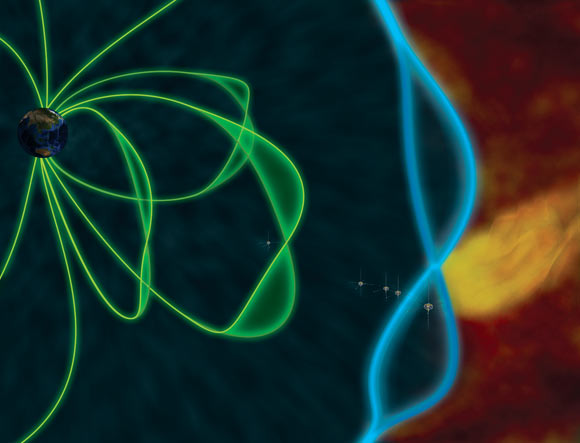As strong impulses strike the Earth’s magnetopause, the abrupt boundary between the planet’s magnetosphere and the surrounding plasma, ripples travel along its surface which then get reflected back when they approach the magnetic poles. The interference of the original and reflected waves leads to a standing wave pattern, in which specific points appear to be standing still while others vibrate back and forth. A drum resonates like this when struck in exactly the same way. A new study, published in the journal Nature Communications, describes the first time this effect has been observed after it was theoretically proposed 45 years ago.

Illustration of a plasma jet impact (yellow) generating standing waves at the boundary (blue) of Earth’s magnetic shield (green). Image credit: E. Masongsong, UCLA / M. Archer, QMUL / H. Hietala, UTU.
Inside the Earth’s magnetosphere, planetary researchers have long been listening in on space sounds created by various electromagnetic waves.
This veritable orchestra of waves can be heard as sound when processed correctly, and they even exhibit similar behaviors to certain musical instruments.
So-called magnetosonic waves pulse through plasma in the same way sound bounces through wind instruments.
Another type of wave, known as an Alfvén wave, resonates along magnetic field lines, just like string instruments’ vibrating strings.
While both of these types of waves can travel anywhere in space, the newly-discovered waves are a type of surface waves — waves that require some sort of boundary to travel along.
In this case the magnetopause acted as the boundary. When a plasma jet — the drumstick — strikes the magnetopause, surface waves form a standing wave pattern — where the ends appear to be standing still while other points vibrate back and forth — just like a drumhead.
The fixed points in the wave, which are the rim or edge of the drum, are near Earth’s magnetic poles; the waves vibrate the surface of the magnetopause in between.
While the wave itself remains on the surface, the vibrations ultimately work their way down into the magnetosphere and trigger other types of waves.
“The waves likely penetrate far into the inner magnetosphere causing ultra-low frequency waves, which affect things like radiation belts, the aurora, and even the ionosphere,” said lead author Dr. Martin Archer, space physicist at Queen Mary University, UK.
Dr. Archer and colleagues used observations from five NASA’s Time History of Events and Macroscale Interactions during Substorms (THEMIS) satellites when they were ideally located as a strong isolated plasma jet slammed into the magnetopause.
The probes were able to detect the boundary’s oscillations and the resulting sounds within the Earth’s magnetic shield, which agreed with the theory and gave the researchers the ability to rule out all other possible explanations.
“Given the lack of evidence over the 45 years since they were proposed, there had been speculation that these drum-like vibrations might not occur at all,” Dr. Archer said.
“Now we see that waves on the magnetopause’s surface reflect between two points near the magnetic poles — acting very much like a drum.”
_____
M.O. Archer et al. 2019. Direct observations of a surface eigenmode of the dayside magnetopause. Nature Communications 10, article number: 615; doi: 10.1038/s41467-018-08134-5







